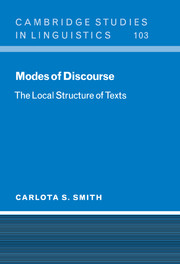Book contents
- Frontmatter
- Contents
- Preface
- Introduction
- PART I DISCOURSE STRUCTURE
- PART II LINGUISTIC ANALYSIS OF THE DISCOURSE MODES
- 4 Aspectual information: the entities introduced in discourse
- 5 Temporal and spatial progression
- 6 Referring expressions in discourse
- PART III SURFACE PRESENTATIONAL FACTORS
- PART IV DISCOURSE MODES AND THEIR CONTEXT
- Appendix A The Texts
- Appendix B Glossary
- References
- General index
- Index of names
6 - Referring expressions in discourse
Published online by Cambridge University Press: 18 June 2010
- Frontmatter
- Contents
- Preface
- Introduction
- PART I DISCOURSE STRUCTURE
- PART II LINGUISTIC ANALYSIS OF THE DISCOURSE MODES
- 4 Aspectual information: the entities introduced in discourse
- 5 Temporal and spatial progression
- 6 Referring expressions in discourse
- PART III SURFACE PRESENTATIONAL FACTORS
- PART IV DISCOURSE MODES AND THEIR CONTEXT
- Appendix A The Texts
- Appendix B Glossary
- References
- General index
- Index of names
Summary
This chapter discusses the contribution of referring expressions to discourse. I first consider in detail the notion of Primary Referent. The Primary Referent is central in a situation, and the key to atemporal text progression. The discussion will complete the linguistically based characterization of the Discourse Modes. With the Discourse Mode analysis fully developed, I turn to other aspects of referring expressions in texts.
Referring expressions convey information by their form. This is possible because the class of referring expressions in a language belong to a closed system. There are a limited number of terms, of which one must be chosen. Choice of a term has contrastive force that may go beyond lexical and referential meaning. Referring expressions give information about the familiarity status of the referent, and signal either continuity or change of direction in a discourse. Within the narrower range of simple and reflexive pronouns, the choice of a pronoun conveys additional, more subtle, notions. These matters are pragmatic in nature.
Section 6.1 discusses Primary Referents and how to determine the primary referring expression in a clause; 6.2 considers referring expressions and closed systems, focusing on pronoun forms and meanings; 6.3 discusses the familiarity status of referring expressions, and their patterns of use in texts; 6.4 considers referring expressions and Discourse Representation Theory.
Atemporal text progression and Primary Referents
Determining the Primary Referent
Progression in text passages of the atemporal modes proceeds by metaphorical motion.
- Type
- Chapter
- Information
- Modes of DiscourseThe Local Structure of Texts, pp. 123 - 152Publisher: Cambridge University PressPrint publication year: 2003



